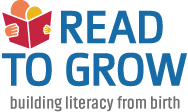Esta página está siendo traducida al español. Gracias por su paciencia.
Recursos de Alfabetización
Books for Kids offers resources to promote early literacy and literacy-developing habits within homes and communities.
Some or all of these resources should be useful for families, educators, health-care providers, child-care providers, and other nonprofits serving children and families.
- Book Selections — Information for selecting appropriate books for children
- Home Libraries — The whys and hows of creating a collection of children’s books at home for regular use
- Related Websites — A list of online resources for literacy information
- Workshops — Please call us directly for more information about workshops that Read to Grow might present to different groups (parents, educators, health-care providers, and others). Call our Books for Kids staff (Linda Sylvester, Evelyn Tomasello or Myra Healy) at: 203.488.6800.
Esta página está siendo traducida al español. Gracias por su paciencia.
Parents of newborns and young children should look for books with colorful pictures or photos and just a few words on each page. Babies and toddlers love pictures of children’s faces, showing smiles and different emotions.
Don’t worry if your child isn’t old enough to understand even simple words. Children need to hear words over and over again to recognize those words and speech patterns. Repetition of words and reading the same books and stories many times are what babies grow to love.
As a child starts to read, you might want to guide her or his book selections. Here are a few tips for your child:
1. A book might be too easy if:
- I have read it many times.
- I understand and can retell the story without much effort.
- I know and understand almost every word.
- I can read the book smoothly and fluently without much practice.
2. A book might be too hard if:
- There are five or more words on a page that I don’t recognize. I have read two pages and there are 5 words I don’t understand.
- I am confused about what is happening in the story.
- When I read the words they sound choppy and slow.
- I need help when I am reading the book.
3. A book might be just right if:
- The book is new to me, and the topic is interesting to me.
- I understand what is happening in most of the story.
- I can retell what I read.
- I recognize most of the words on the page, but there are some words to work on.
- I can read the book by myself but may need help when I hit a tough spot.
Reading just-right books provides the perfect balance so that readers feel successful, enjoy reading and grow in their abilities. If books are too easy, children will become stagnant in their reading. Books too high above their reading levels will do nothing but frustrate them. You want your children to be happy and confident readers.
Esta página está siendo traducida al español. Gracias por su paciencia.
Research shows that having books in the home is one of the best ways to support and encourage your child’s learning and academic achievements. In fact, the number of books in a home is a stronger predictor of a child’s eventual level of education than are the household income and the parents’ levels of education.
Having a home library delivers the message that books are fun, important and part of everyday life.
Tips for starting a home library:
- Ask for books as gifts for your child (or for you);
- Look for inexpensive books at tag sales;
- Look for inexpensive books at second-hand stores;
- Make your own special books with your child at home.
Tips for creating accessible spaces for books:
- Put books in a large basket, a plastic laundry basket, a milk crate, or a sturdy cardboard box and put that container in the corner of a room—not out of sight and not out of reach.
- Build a reading nook with a large cardboard box (on its side) and a crib mattress, a blanket, and/or pillows;
- Use a low-level bookshelf that won’t topple over.
Search “home libraries for children” for more ideas. Also, look at these websites:
Esta página está siendo traducida al español. Gracias por su paciencia.
Online Resources for Information on Literacy
For Books and Reading Activities:
- American Library Association
- Brightly
- Center for the Book
- Children’s Book Council
- The Children’s Literature Web Guide
- Colorín Colorado
- Esme Raji Codell
- Guys Read
- Jim Trelease’s Home Page
- National Children’s Literacy Website
- ReadKiddoRead
- Reading Rockets
- Reading Is Fundamental (RIF)
- Dolly Parton’s Imagination Library
